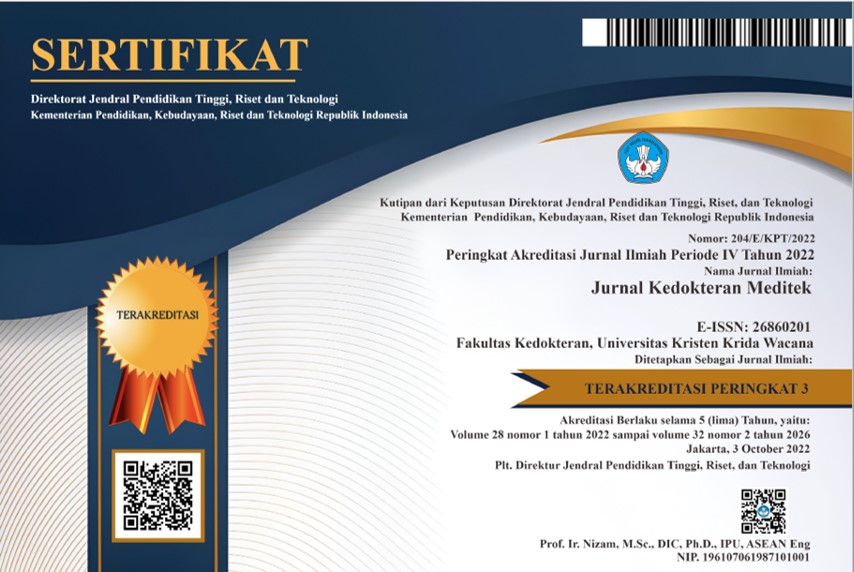Uji Kadar Likopen dan Aktivitas Antioksidan pada Buah Tomat
DOI:
https://doi.org/10.36452/jkdoktmeditek.v25i3.1778Keywords:
antioxidant activity, lycopene, tomato (Solanum lycopersicum)Abstract
Oxidative stress, a condition of imbalanced free radicals and antioxidant in our body has long been associated with the occurrence of atherosclerosis, inflammation, cancer, and aging. Increased oxidative stress, due to high fat intake and pollution requires the consumption of antioxidant compounds from food or food supplements. Tomatoes (Solanum lycopersicum) has been known to have a high content of lycopene that is capable of controlling free radicals 100 times more efficiently than vitamin E and 12500 times than glutathione peroxidase which is an endogenous antioxidant enzyme. The purpose of this study was to determine lycopene content and antioxidant activity of tomatoes. Antioxidant activity was determined spectrophotometrically based on a DPPH method, whereas lycopene content was determined based on its absorbance and its specific absorbance. This study found that the IC50 of tomatoes was 60 µg/ml which is classified as strong antioxidant, and lycopene content in tomatoes was 3.42 mg / kg fresh sample. Therefore, this study may conclude tomatoes as a good source of antioxidant.
References
2. V lobo, et al. Free radicals, antioxidants and functional foods: impact on human health. Pharmacogn rev. 2010;4(8):118-26
3. Andayani R, Maimunah, Lisawati Y. Penentuan aktivitas antioksidan, kadar fenolat total dan likopen pada buah tomat (Solanum lycopersicum L). J Sains Tek Far. 2008; 13(1):31-6
4. Winarsi H. Antioksidan alami dan radikal bebas, potensi dan aplikasinya dalam kesehatan. Yogyakarta: Kanisius ; 2007.h.26-45
5. Ho E, et al, Biological markers of oxidative stress: applications to cardiovascular research and practice. Redox Biology 1. 2013: 483–491
6. Noda N, Wakasugi H, Cancer and stress oxidative. JMAJ. 2001; 44(12): 535–539
7. Gandhi S, Abramov AY. Mechanism of oxidative stress in neurodegeneration. Oxidative Medicine and Cellular Longevity.2012:1-7
8. Hosseini A, Abdollahi M. Diabetic neuropathy and oxidative stress: therapeutic perspectives. Oxid Med Cell Longev. 2013;1-7
9. Sandireddy R, et al. Neuroinflammation and oxidative stress in diabetic neuropathy: futuristic strategies based on these targets. International Journal of Endocrinology. 2014:1-5
10. Chopra M, et al, Oxidative stress in diabetic neuropathy: source of reactive oxygen species. Endocrinology Studies. 2012; 2(6):22-4
11. Thompson LP, Al-Hazan Y. Impact of oxidative stress in fetal programming. Journal of Pregnancy. 2012:1-5
12. Maong R, Rorong JA, Fatimah F. Aktivitas ekstrak buah tomat (Lycopersicum esculentumMill) sebagai penstabil oksigen singlet dalam reaksi fotooksidasi asam linoleat. Jurnal Mipa Unsrat Online. 2016 ; 5(1): 60-4
13. Mu’nisa A. Analisis kadar likopen dan uji aktivitas antioksidan pada tomat asal Sulawesi Selatan. Jurnal Bionature. 2012; 13(1): 62-6
14. Kumar PVN, Et al. A systematic review on lycopene and its beneficial effects. Biomed & Pharmacol J. 2017;10(4): 2113-8
15. Metha N, Patani P, Singhvi I. A review on tomato lycopene. IJPSR. 2018; 9(3):916-21
16. Amarowicz R. Lycopene as a natural antioxidant. Eur J Lipid Sci Technol. 2011; 113: 675-6
17. Novita M, Satriana, Hasmarita E. Kandungan likopen dan karotenoid buah tomat (Lycopersicum pyriforme) pada berbagai tingkat kematangan: pengaruh pelapisan dengan kitosan dan penyimpanan. Jurnal Teknologi Dan Industri Pertanian Indonesia.2015;7(1):35-9
18. Suwanaruang T. Analyzing lycopene content in fruits. Agriculture and Agricultural Science Procedia. 2016; 11: 46 – 48
19. Socaciu C. Food colorants, chemical and functional properties. USA: CRC Press; 2008.p.57
20. Kedare SB, Singh RP. Genesis and development of DPPH method of antioxidant assay. J Food Sci Technol. 2011; 48(4): 412-3
21. Sayuti K, Yenrina R. Antioksidan alami dan sintetik. Padang: Andalas University Press; 2015.h.1-15
22. Novelina, Nazir N, Adrian MR. The improvement lycopene availability and antioxidant activities of tomato (Lycopersicum esculentum, mill) jelly drink. Agriculture and Agricultural Science Procedia. 2016; 9 : 328 – 334
23. Alda LM, et al. Lycopene content of tomatoes and tomato products. Journal of Agroalimentary and Technologies.2009; 15(4):542

















